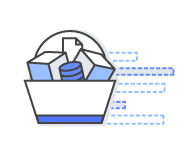How does AWS pricing work?
Pay as you Go
AWS offers, pay as you go model, that is you only pay what you use.
Let’s take an example to understand this:
Suppose you are using say 10GB of space on AWS infrastructure, now usually what happens is, you estimate your usage say 40GB, reserve it, and pay for that 40GB monthly. But what if you are not using the whole 40GB. Like in our example, you just have 10GB of data, so if you are using AWS, you just pay for that 10GB, and you can always store more as your requirements grow, there is no restriction!
Payless by using more

Confusing? But it’s true. AWS bills you for the hour. The more AWS resources you use, the less the hourly rates become.

Source: AWS Pricing
Save when you reserve

Though AWS has on-demand instances, but in services like AWS EC2 and RDS you have an option of reserving your instances as well, for a specific time frame. Why would you reserve? You can reduce your costs up to 75 percent when you use reserved instances compared to On Demand instances.
AWS Pricing Models

Having said that, there are 3 different pay models when you use Reserved Instances:
Let’s discuss each one of these:
No Upfront
- In No upfront, you don’t pay anything before you reserve the instance, but since there is no advance payment, the costs are higher than the other two options.
Partial Upfront
- In Partial Upfront, you pay a partial amount when you are reserving the instance, the costs in this model are lesser as compared to No upfront, but is still more expensive than full upfront.
Full Upfront
- In Full Upfront, you pay the whole amount when you are reserving the instance, and the pricing is least in this case, since you are paying the full payment.
Calculate your savings

AWS offers two types of calculators for you to foresee what will be your expenses:
- AWS Calculator
- TCO Calculator
AWS Calculator
AWS Calculator is used to calculate your monthly expenses, it can be used to foresee, what will be your expenditure if you use a certain set of resources, it also provides you with templates to appraise complete solutions.
TCO Calculator
TCO(Total Cost of Ownership) Calculator is used to compare one service’s price to another, or one infrastructure solution to the other, it matches your current infrastructure to the most cost-efficient AWS offerings.
AWS Free Tier
Let’s talk about the most exciting part of AWS pricing first, that is the AWS Free tier. They are offered by AWS to their customers so that they can get a hands-on on AWS services so that they would know what they will be paying for.
The free tier from AWS offer two kinds of free service
The Introductory free tier is given to all AWS customers on their SignUp, and it is valid for 12 months from the day they register on AWS. You can learn more about this from the AWS certification course.
Check out our AWS Certification Training in Top Cities
The following are the services and their features that are included in the free tier:
- Amazon EC2

- It offers 750 hours of free Windows or Linux t2.micro instance usage per month.
- So you can either run 1 instance for 750 hours for one month or two instances for half a month.
- Amazon S3

- It offers 5GB of standard storage on S3
- 20,000 Get requests
- 2,000 Put requests
- Amazon RDS

- 750 hours of free db.t2.micro instance
- 20 GB of DB storage: any combination of SSD or Magnetic
- 20GB of backups with RDS Magnetic storage
- 10,000,000 IOs
- Amazon CloudFront

- 50GB Data Transfer Out,
- 2,000,000 HTTP and HTTPS requests of CloudFront.
- Data Transfer
- 15GB of data transfer out aggregated out of all AWS services.
The non-expiring free tier does not expire even after 12 months, and includes the following services:
- AWS Lambda

- 1,000,000 free requests per month
- 3.2 million seconds of computing time per month
- AWS KMS

- 20,000 free requests per month
- Amazon SES

- 62,000 outbound messages per month to any recipient when you call Amazon SES.
- 1000 inbound messages per month.
- Amazon CloudWatch

- 10 Amazon CloudWatch custom metrics, 1,000,000 API requests.
- 5GB of log data ingestion.
- 5GB of log data Archive.
- 3 Dashboards with up to 50 metrics each per month.
- DynamoDB

- 25GB of storage
- 25 Units of read capacity and 25 units write capacity
Since pricing changes for AWS resources pretty often, you can get the updated pricing for all AWS resources or services from the Pricing page of AWS. You can learn more from the AWS Cloud Practitioner Certification.
So that’s it guys! I hope you enjoyed this AWS Pricing blog. The knowledge of how AWS pricing works is a must for any AWS Solution Architect Professional. Edureka has a curriculum that covers exactly what you would need to crack the Solution Architect Exam!
Are you ready to take your skills in AWS to the next level and become an expert in DevOps? Enroll now in our AWS DevOps Certification Course and gain the knowledge and skills needed to design, deploy, and manage robust and scalable AWS infrastructure.
Unlock your potential as an AWS Developer by earning your AWS Developer Certification. Take the next step in your cloud computing journey and showcase your expertise in designing,
Got a question for us? Please mention it in the comments section of this AWS Pricing blog and we will get back to you.






















Comments
Post a Comment